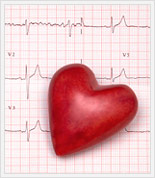|
|
The Fat-burning Zone Myth
QUESTION:
I have often heard that you need to exercise at a low intensity or low heart rate to get into a "fat-burning zone" that will favor a loss in body fat. Is this true?
ANSWER:
 The "fat-burning zone" is one of the many misconceptions that seem to be passed from one exerciser to another. The explanation for the myth is a combination of misinterpreted biochemistry and exercise physiology, inadequate education of many workers in the fitness industry, and a magazine culture that often favors sensationalism over scientific fact. The "fat-burning zone" is one of the many misconceptions that seem to be passed from one exerciser to another. The explanation for the myth is a combination of misinterpreted biochemistry and exercise physiology, inadequate education of many workers in the fitness industry, and a magazine culture that often favors sensationalism over scientific fact.
Let's start with a brief explanation of where this belief comes from.
Our body uses a mix of fat and carbohydrate to fuel the energy needs of our cells. Researchers can quantify this mix with high accuracy in an exercise physiology laboratory using expired gas analysis. The percent contribution of fat and carbohydrate does indeed vary depending on the intensity of exercise.
For instance, when we transition from rest to exercise, there is an increase in energy expenditure (i.e., calories burned) to meet the increased needs of our muscles. When the exercise is of a low intensity, our bodies preferentially use fat as a fuel, similar to a resting state. Thus, low intensity exercise does predominantly rely on fat to fuel contracting muscles.
As the exercise intensity increases, added neural stimulation, hormone concentrations, and a complex regulation of muscle metabolism causes a progressively increased dependence on carbohydrate catabolism. The greater the increase in exercise intensity, the greater the dependence on carbohydrate until eventually only carbohydrate is used by muscles to fuel contraction.
The misinterpretation stems from overlooking the fact that the total amount of fat used during exercise is actually a combination of two variables:
- the proportion of fat used to fuel the muscle contraction
- the total energy expended during exercise.
If you only rely on low intensity exercise to burn fat during exercise, then your total calories burned per minute will be low. Thus, you would have to exercise for a long time to burn a significant amount of fat. Conversely, exercising at a higher intensity, even though the proportion of fat contribution is lower, can result in a similar fat combustion because the total amount of calories burned is higher. The following table highlights this comparison.
Examples of computations for fat loss during exercise at different intensities.
| Exercise Intensity |
Calories* |
Fat % |
Carb % |
Fat Lost (g) |
| Low |
213 |
85 |
15 |
20 |
| Moderate to Vigorous |
555 |
30 |
70 |
18.5 |
|
* Energy expenditure (calories) based on a 45 min constant intensity workout
As you can see, even though the percentage of fat contribution differs, exercising for 45 minutes at a low intensity vs. exercising at a moderate to vigorous intensity will expend nearly the same amount of fat. However, the moderate to vigorous exercise intensity workout is further benefited by more than double the total calories burned!
The key to understanding body fat reduction from exercise is to follow this simple rule:
Caloric balance = energy ingested - energy expended
The body fat loss from exercise is based, not only on the fat burned during exercise, but also on the caloric deficit you generate from a sound diet in combination with adequate exercise and physical activity.
It should also be noted that higher intensity exercise training results in greater training adaptations as compared to those seen with lower intensity workouts. For instance, higher intensity workouts result in greater changes in muscle structure and function, as well as cardiovascular system structure and function. These changes improve endurance fitness. This is great news because fitter bodies utilize a greater percentage of fat calories throughout the day, both during exercise and at rest! In addition, being fit will allow you to exercise at higher intensities for longer, resulting in increased calories burned during subsequent workouts.
So take the focus off of working out in the low-intensity "fat burning" zone, and focus on the overall quality of your workout. If you are a beginner, you will need to start off with low-intensity exercise. However, as you become more fit and adapt to your exercise sessions, you can start incorporating higher intensity bouts into your workouts, thus reaping more benefits.

Related Articles:
|
 |
 |
Our expert, Dr. Sharon E. Griffin, holds a B.S., M.S., and Ph.D. in the areas of exercise science/physiology. She also holds a second M.S. degree in Nutrition and is a licensed nutritionist and an ACSM certified health and fitness instructor.
|

